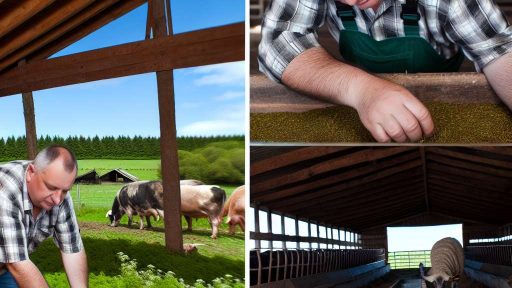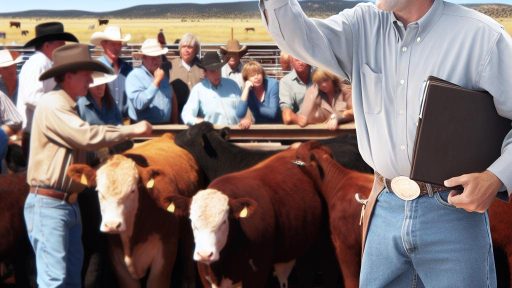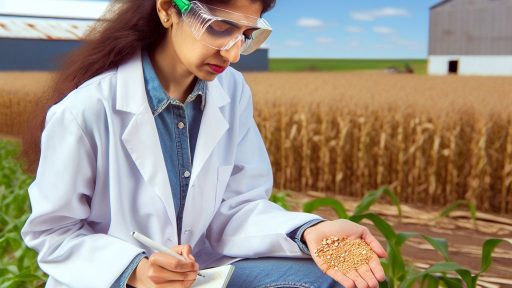Understanding Beef Cattle Growth Stages and Nutritional Needs
Growth Stages of Beef Cattle
Beef cattle undergo distinct growth stages throughout their lives.
These stages include the neonate, weaning, growing, and finishing phases.
Each stage presents unique nutritional requirements.
Understanding these stages helps farmers optimize feeding plans.
Nutritional Needs during the Neonate Stage
Newborn calves require colostrum shortly after birth.
This first milk provides essential antibodies for immunity.
In this stage, proper hydration is crucial for calf health.
Additionally, high-quality forage supports their initial growth.
Nutritional Needs during Weaning
Weaned calves need a balanced diet to support rapid growth.
A mix of forages and grains enhances their nutritional intake.
Protein is vital during this stage for muscle development.
Supplementing minerals and vitamins also plays a key role.
Nutritional Needs during the Growing Phase
Growing cattle experience significant body mass increase.
A high-energy diet promotes efficient weight gain.
Quality forage should be readily available to them.
Transform Your Agribusiness
Unlock your farm's potential with expert advice tailored to your needs. Get actionable steps that drive real results.
Get StartedProviding adequate protein levels is essential for this stage.
Regular monitoring ensures they receive all nutrients needed.
Nutritional Needs during the Finishing Phase
Finishing cattle focus on gaining fat for market readiness.
This stage requires energy-dense feed for optimal growth.
Grain-based diets are commonly utilized during finishing.
Calcium and phosphorus are essential for skeletal health.
Farmers should closely manage ration formulations for best results.
Nutritional Strategies for Beef Cattle
Understanding the growth stages aids in developing effective feeding plans.
Each phase demands specific nutritional approaches.
Effective management leads to maximum growth potential in beef cattle.
Key Components of a Balanced Diet for Beef Cattle
Essential Nutrients
A balanced diet for beef cattle includes essential nutrients.
These nutrients support optimal growth and overall health.
Key nutrients include proteins, carbohydrates, fats, vitamins, and minerals.
Protein Sources
Protein is crucial for muscle development and growth.
Common protein sources include soybean meal and alfalfa.
Beef cattle benefit from a high-protein diet during the finishing phase.
Role of Concentrates
Concentrates provide high-energy feeds.
These include grains like corn and barley.
High-energy feeds promote rapid weight gain.
Fiber Requirements
Fiber is essential for proper digestion and gut health.
Beef cattle require forages like hay and silage for fiber.
Fiber helps maintain rumen function and prevents digestive disorders.
Vitamins and Minerals
Vitamins and minerals play critical roles in bodily functions.
Vitamin A, D, and E are vital for immune health.
Showcase Your Farming Business
Publish your professional farming services profile on our blog for a one-time fee of $200 and reach a dedicated audience of farmers and agribusiness owners.
Publish Your ProfileMinerals like calcium, phosphorus, and magnesium support bone development.
Ensuring Mineral Balance
A mineral supplement can help achieve balance.
Free-choice mineral blocks are commonly used in cattle diets.
Monitoring mineral intake ensures optimal health performance.
Water Quality and Availability
Fresh water is a fundamental need for beef cattle.
It supports digestion and nutrient absorption.
Ensure continuous access to clean and safe water sources.
Feeding Management Practices
Effective feeding management enhances diet quality.
Regularly assess the quality of feed sources.
Adjust feeding plans based on cattle growth stages and needs.
Understanding Feed Conversion Ratios
Feed conversion ratio measures efficiency in converting feed to weight gain.
Monitoring this ratio helps improve feeding strategies.
Better ratios indicate more efficient feeding practices.
Formulating Feeding Plans Based on Cattle Breeds and Purposes
Understanding Cattle Breeds
Different cattle breeds have unique nutritional requirements.
Understanding these differences is essential for optimal growth.
For example, Angus cattle thrive on energy-rich diets.
In contrast, Hereford cattle require a balanced protein intake.
Researching breed-specific diets can enhance growth performance.
Defining Purpose in Beef Production
Identifying the purpose of beef cattle is crucial for feeding plans.
Some cattle are raised for premium beef quality.
Others are bred for efficient meat production rates.
Tailoring diets to these purposes boosts overall effectiveness.
Growing vs. Finishing Diets
Growing diets are designed for young, developing cattle.
They focus on protein and minerals to support growth.
Finishing diets target weight gain before slaughter.
These diets are high in energy and fat content.
Formulating Nutritional Components
Nutrition plays a vital role in a successful feeding plan.
Components include protein, carbs, fats, vitamins, and minerals.
High-quality forage is important for overall health.
Additionally, concentrates can boost energy intake.
Protein Sources
Protein is essential for muscle development in cattle.
Good sources include soybean meal and alfalfa.
Feeding is crucial during the growing phase for young cattle.
Energy Sources
Energy sources impact weight gain directly.
Corn and barley are commonly used in beef diets.
They provide the necessary calories for finishing cattle.
Adjusting Diets Based on Growth Stages
The nutritional strategy must adapt as cattle grow.
Calves have different needs compared to yearlings or adults.
Monitoring growth and adjusting diets accordingly is important.
This ensures that cattle reach their growth potential.
Showcase Your Farming Business
Publish your professional farming services profile on our blog for a one-time fee of $200 and reach a dedicated audience of farmers and agribusiness owners.
Publish Your ProfileMonitoring and Evaluating Feed Efficiency
Regular evaluation of feed efficiency is critical.
Measurement can involve tracking weight gain versus feed intake.
Adjustments may be necessary based on these evaluations.
Ultimately, this leads to improved growth rates.
Explore Further: Pest Control Strategies For Livestock Housing
The Role of Forage Quality in Beef Cattle Weight Gain
Importance of High-Quality Forage
High-quality forage plays a vital role in beef cattle weight gain.
It provides essential nutrients that support growth and health.
Additionally, quality forage enhances digestion and nutrient absorption.
Ultimately, cattle that consume better forage gain weight faster.
Types of Forage and Their Impact
Different types of forage offer varying nutritional profiles.
Grass-based forages tend to have high fiber content.
This can slow down digestion in cattle, affecting weight gain.
In contrast, legume forages are typically more nutrient-dense.
Cattle thriving on legumes often exhibit quicker weight gain.
Evaluating Forage Quality
To evaluate forage quality, consider several key factors.
These factors include protein content, fiber level, and palatability.
Testing forage samples helps farmers make informed feeding decisions.
High protein levels correlate with increased weight gain in cattle.
Forage Management Practices
Effective management of forage is crucial for optimizing growth.
Rotational grazing can enhance pasture quality over time.
This method promotes regrowth and improves soil health.
Moreover, timely harvesting of hay prevents nutrient loss.
Supplementing Forage with Additional Feed
Sometimes, cattle require additional feed alongside forage.
Supplements can boost nutrient intake and support weight gain.
Common supplements include grains and high-protein feeds.
Careful balance in the diet ensures healthy growth rates.
Find Out More: Health Management in Exotic Farming
Supplementation Strategies for Optimal Muscle Development
Importance of Nutritional Balance
Nutritional balance is critical for muscle development in beef cattle.
Adequate energy, protein, vitamins, and minerals promote optimal growth.
Moreover, a well-formulated diet improves feed efficiency.
Protein Sources for Cattle
Quality protein sources enhance muscle development significantly.
Common options include soybean meal and cottonseed meal.
Also, distillers grains can provide a cost-effective protein boost.
Utilizing Non-Protein Nitrogen
Non-protein nitrogen aids in rumen function and protein synthesis.
Urea is a popular choice for non-protein nitrogen sources.
However, careful management is vital to prevent toxicity.
Energy Supplements
Energy supplements play a crucial role in muscle development.
High-quality grains like corn provide concentrated energy sources.
Additionally, fats can enhance energy density in diets.
Using Fats Wisely
Incorporating fats in moderation boosts energy per pound of feed.
Showcase Your Farming Business
Publish your professional farming services profile on our blog for a one-time fee of $200 and reach a dedicated audience of farmers and agribusiness owners.
Publish Your ProfileExamples of fat sources include vegetable oils and tallow.
Always adjust fat levels based on dietary needs and growth stages.
Mineral and Vitamin Inclusion
Minerals and vitamins are essential for healthy muscle growth.
Calcium and phosphorus support bone health and muscle function.
Vitamin E and selenium improve muscle recovery and immune response.
Monitoring and Adjusting Diets
Regularly assess cattle nutrition for maximum efficiency.
Conduct feed testing to ensure nutrient adequacy.
Furthermore, adjust rations based on growth stages and health.
Creating a Feeding Schedule
Consistency in feeding promotes better digestion and absorption.
Develop a routine that accommodates cattle needs naturally.
Finally, ensure fresh water is always available for optimal health.
You Might Also Like: Sustainable Livestock Waste Solutions For Farms

Monitoring and Adjusting Feeding Plans for Seasonal Changes
The Importance of Seasonal Adjustments
Seasonal changes significantly impact beef cattle feeding plans.
Feed availability, nutritional requirements, and growth rates fluctuate seasonally.
Regularly monitoring these changes is crucial for optimal growth.
Identifying Nutritional Needs by Season
Spring often brings lush pastures, offering high-quality forage.
During this season, cattle can benefit from reduced supplemental feeding.
Conversely, winter months may require increased grain to maintain weight.
Monitoring cattle body condition scores helps to adjust diets accordingly.
Adjusting Feed Composition
The composition of cattle feed should vary with the seasons.
For example, protein percentages may need adjustment based on forage quality.
Moreover, energy needs increase during colder months as cattle conserve heat.
Utilizing feed analysis ensures proper nutrient balance throughout the year.
Implementing Regular Monitoring Practices
Regular weigh-ins and health checks allow for timely dietary adjustments.
Keeping detailed records of feed intake and growth rates is essential.
By documenting changes, farmers can identify patterns and predict future needs.
Leveraging Technology for Monitoring
Technology aids in accurate monitoring of cattle health and diet.
Automated feeders can adjust rations based on real-time data.
Software tools can track growth rates, feed conversion, and health metrics.
These technologies help farmers react swiftly to seasonal challenges.
Long-Term Strategies for Seasonal Feeding
Developing a comprehensive feeding plan requires foresight.
Planning for seasonal transitions can mitigate potential issues.
Reviewing past data equips farmers with insights for future adjustments.
Collaboration with livestock nutritionists can enhance feeding strategies.
Communicating with Feed Suppliers
Engagement with feed suppliers ensures access to necessary resources.
Suppliers often provide valuable insights into feed composition changes.
Establishing solid relationships promotes better planning and resource availability.
See Related Content: Biosecurity Measures For Livestock Housing
Feeding Management Techniques to Enhance Conversion Rates
Understanding the Importance of Feeding Management
Feeding management directly influences cattle growth rates.
Proper nutrition ensures optimal weight gain and feed efficiency.
Showcase Your Farming Business
Publish your professional farming services profile on our blog for a one-time fee of $200 and reach a dedicated audience of farmers and agribusiness owners.
Publish Your ProfileImplementing effective feeding strategies can significantly reduce costs.
Choosing the Right Feed
Selecting high-quality feed is crucial for beef cattle growth.
Forage-based diets should include a mix of grasses and legumes.
Concentrates can enhance energy intake during critical growing phases.
Regular analysis of feed ingredients helps maintain nutrient balance.
Feeding Frequency and Timing
Adjusting feeding frequency can optimize consumption rates.
Feed cattle at regular intervals to stabilize rumen function.
Consider feeding during cooler parts of the day to increase intake.
Offering smaller, more frequent meals encourages better digestion.
Supplementing Nutritional Needs
Consider using supplements to fill nutritional gaps.
Minerals and vitamins play a vital role in cattle development.
Enhanced protein sources can boost growth rates significantly.
Evaluate the need for additional energy-forming supplements.
Monitoring Body Condition and Health
Regularly assess cattle body condition scores to gauge health.
Monitor for signs of illness that may affect feeding habits.
Healthy cattle show better feed conversion and growth rates.
Maintain meticulous health records to track changes in feeding responses.
Implementing Technology in Feed Management
Using technology can streamline feeding processes.
Automated feeders ensure consistent rations are provided.
Data tracking software helps analyze feed efficiency metrics.
Consider using smart sensors for real-time monitoring of cattle health.
Adapting to Seasonal Changes
Feeding strategies should change with the seasons.
Winter months may require additional energy sources.
Adjust diets according to forage availability in spring and summer.
Seasonal feeding adjustments can maximize growth potential.
Common Challenges in Beef Feeding and Practical Solutions
Nutritional Deficiencies
Nutritional deficiencies often hinder beef cattle growth.
Common deficiencies include protein and energy shortages.
To combat this, conduct regular nutritional assessments.
Additionally, supplement feeds with high-quality ingredients.
Weight Management Issues
Weight management is crucial for effective beef production.
Beef cattle can either overgain or undergain weight.
Overgaining can lead to health problems, such as fat deposition.
Implementing a structured feeding schedule addresses this issue.
Moreover, adjust feed rations based on growth stage and conditions.
Inconsistent Feeding Practices
Inconsistent feeding practices adversely affect growth rates.
Varying feed types and amounts can create digestive problems.
To improve this, establish a routine feeding plan.
Track feeding habits to ensure uniformity across the herd.
Market Price Fluctuations
Market price fluctuations impact the overall profitability of beef production.
Producers may struggle to choose the correct feeding strategies.
Showcase Your Farming Business
Publish your professional farming services profile on our blog for a one-time fee of $200 and reach a dedicated audience of farmers and agribusiness owners.
Publish Your ProfileTo mitigate risks, use forward contracting to lock in prices.
Additionally, diversify feed sources to control costs better.
Health Problems
Health issues can significantly slow cattle growth.
Common problems include respiratory diseases and parasitic infestations.
Regular health checks help identify and treat issues early.
Furthermore, vaccinations and deworming should be part of the routine.
Feed Quality Concerns
Feed quality directly influences cattle growth and health.
Low-quality feed can lead to poor weight gain.
Testing feed through laboratory analysis ensures proper nutrition.
Additionally, store feed in optimal conditions to maintain quality.
Additional Resources
Feed Additives for Beef Cattle Production | Oklahoma State University




